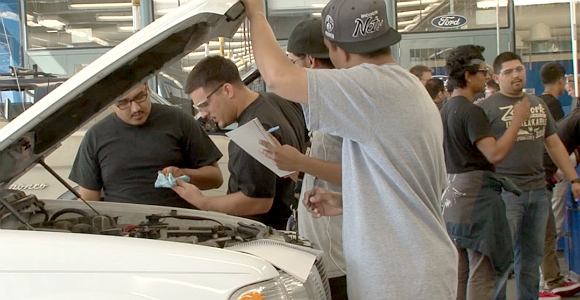
(Photo Credit: John Guenther/CAFwd)
The California Community Colleges announced the launch of Strong Workforce Stars, a program that recognizes successful career education programs. More than 100 programs at 65 community colleges were noted for having students earn a substantial increase in earnings and attain a living wage in a job closely matched with the student’s field of study.
“It is reassuring for those of us who think about the future of California to see the great progress that is being made in California's community colleges to address our critical workforce shortage,” said Lenny Mendonca, CA Fwd Leadership Council co-chair. “More trained workers earning increased salaries is a critical step toward addressing the income inequality issue that is hurting our state.”
The issue of social mobility is a major one in California—18 million Californians live in or near poverty. Addressing workforce skills—particularly for middle-skills jobs—is a part of everyone’s prescription for providing public policy answers to expanding the middle class.
To underscore the critical need for more middle-skills jobs—just this week Georgetown University issued a report stating there are 30 million good paying jobs that don’t require a college education. The number of good jobs continues to grow, but they are changing from traditional blue-collar industries to skilled-services industries. A gain of four good million jobs in skilled services industries, such as financial services and health services, has more than offset the 2.8 million good jobs lost in manufacturing.
In California alone, the need for middle-skills workers has been estimated to be more than one million by 2025 and the California Economic Summit issued the challenge of training that many to fill jobs opening during that period.
“Employers in California need more trained workers in order for the state to sustain its place as a global economic power,” said Alma Salazar, vice president of education and workforce development for the Los Angeles Area Chamber of Commerce. “The Strong Workforce Stars report is an indication that we are having some early success in meeting that challenge. It is important that progress not only continues but accelerates.”
The Workforce Stars program highlights college and programs that are achieving the following metrics:
- Fifty percent or more increase in student earnings, determined by comparing students' earnings one year before and one year after exiting the California Community Colleges system. This data is based on a match to the state's wage file.
- Seventy percent or more of students attain a regional living wage. This percentage, aligned with a threshold set by the California Workforce Development Board, analyzes the proportion of graduates and skills builders (defined as students whose goal is not to complete a program, but to take classes to increase job skills) who attained the living wage for a single individual in the college's region. This analysis is based on a match to the state's wage file and a comparison with data from the Insight Center for Community Economic Development.
- Ninety percent or more of students report that their current job is close or very close to their field of study. This is based on responses to the system's CTE Outcomes Survey, which is sent to community college students after they stop taking courses.
“The community colleges are key to meeting the challenge of training one million more skilled workers in California,” said Jim Mayer, CA Fwd President and CEO. “Improving the number of good-paying middle-class jobs is critical to restoring upward mobility and the success of the Strong Workforce Program in training people for those jobs is a reason for optimism.”
The Strong Workforce release includes a list of colleges and programs that have been commended and can be seen here.
To raise awareness about the broader issue of economic insecurity, the California Economic Summit has launched a state conversation—called Elevate CA–to develop some public policy ideas for addressing the shrinking middle class in California. Read what Californians are saying here.

